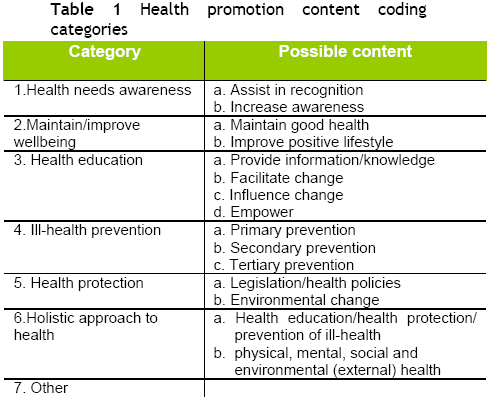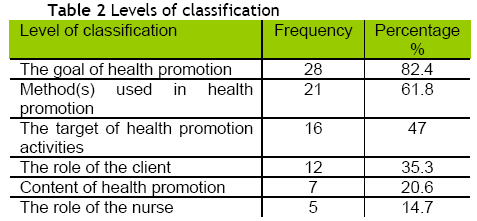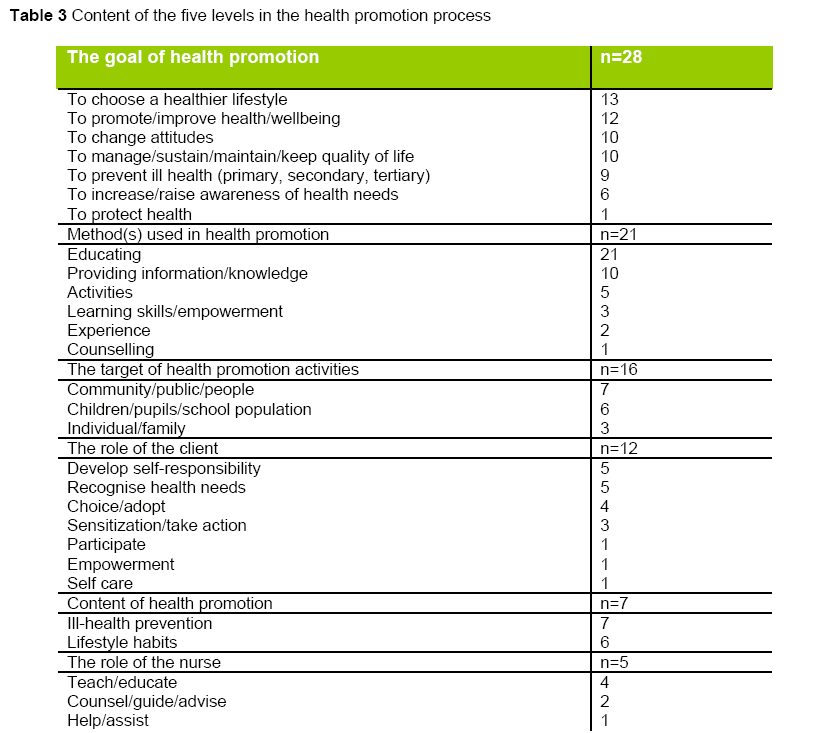Keywords
School nursing, content analysis, qualitative study, special education school, health promotion, health education, Greece
Introduction
Literature review has revealed a large amount of studies referring to concept analysis as well as efforts to define health promotion [1-5]. Tones and Green 6 cite that health promotion definition is a matter of how health promotion is viewed, either as an umbrella term covering the activities of a range of disciplines or as a discipline in its own right. Furthermore, Whitehead 5 argues that it is very difficult to provide a ‘final’ definition of health promotion.
This paper brings forward what school nurses believe about the meaning of health promotion and not just what authors believe. School nurses’ view has a tremendous impact on whether they incorporate health-related concepts in their daily practice and on the way they are involved in health promotion.
Therefore, conceptualization is necessary as it reveals concept advancements and clarification which help researchers to conduct research and generate theory.
Literature review
For the purpose of the present study there has been an extensive literature review focusing on how nurses view health promotion. The bibliographic databases CINAHL, Pubmed, intershience.com and sciencedirect.com were searched for the years 1990 onwards. Key words used were: nurses, school nurses, health promotion, health education, perceptions. A secondary search was conducted by investigating the reference lists of the gathered literature.
Literature review provided two articles that dealt with nurses’ perceptions on health promotion. Sourtzi [7] investigated how community nurses view health promotion using a cross-sectional survey on a sample of 196 nurses in England who answered an open question on the meaning of health promotion. Whitehead et al [8] explored how sixteen hospital nurses perceived health promotion in China by using a Husserlian phenomenological approach. Both studies concluded in the value of education in health promotion as well as in the need of integration and practical implementation of health promotion in nursing practice.
The study
Aim
The aim of the study was to explore Greek school nurses’ perceptions of health promotion.
The research question was: “How Greek school nurses conceptualise health promotion concept?”.
Methodology
Design
The method used for collecting data was a cross-sectional questionnaire survey based on the study by Sourtzi [7]. Content analysis was used for the data resulting from the open question [9]. The study was carried out in March 2005.
Participants
Provided that school nurses in Greece in terms of legislation work only in schools of special education and due to their exceptional small number there was an effort that all forty five school nurses be approached. Consequently there was no sampling process, since the study referred to the whole Greek population of school nurses in March 2005 [10,11].
All school nurses were approached through mailed questionnaires (n=45). The returned questionnaires were fully and correctly completed and all were used in the study. Response rate was 75.55% (n=34).
Data collection instrument
The questionnaire addressed to the school nurses included one open question related to school nurses’ concept of health promotion. The question was: “In your opinion what do the terms Health Promotion and Health Education include?” and it was used following permission by Sourtzi [7]. The content coding categories used resulted from Sourtzi’s study [7] in which intra-rater agreement coefficient was 90%.
Ethical considerations
The University of Athens Faculty of Nursing Ethic’s Committee approved the study, as this was part of the master’s degree in Community Nursing.
School nurses were approached by telephone to inform them about the study and to secure their permission for receiving the questionnaire as it was set out at individual basis. Thirty eight questionnaires were dispatched via conventional mail to the houses of school nurses and seven via electronic mail in personal addresses.
The envelope dispatched to the school nurses via conventional mail contained the questionnaire, an accompanying letter and a response envelope. The accompanying letter was personal for each school nurse and contained concise information on the study and on the completion of the questionnaire. Also, it informed school nurses that their participation to the study was voluntary and that the questionnaires’ completion was anonymous and confidential. They were also given the principal researcher’s contact information. The participants’ response envelopes had only the researcher’s name and address on, it and no identifying information of participants to maintain anonymity at the return of the questionnaires.
As for the electronic mail, questionnaires were sent with personal accompanying letters. The anonymity of those participating by that means was not feasible, because of the absence of an electronic system that would destroy the electronic addresses. Thus, confidentiality was preserved with the direct destruction of the electronic files and the blending of these questionnaires with those of the conventional mail so the return source of the surveys was blinded to the researcher.
Data analysis
Answers were content analyzed in three phases. In phase one the conceptual distinction between the terms “health promotion” and “health education” was examined as those were the predominant terms. In phase two items were examined for their theoretical content according to the content coding categories produced by Sourtzi [7], which are presented in Table 1. In phase three each item was categorised in one of the five levels in the process of health promotion identified in the same study [7] presented in Table 2 and these are: (a) The target of health promotion activities, (b) The goal of health promotion, (c) Method(s) used in health promotion, (d) Content of health promotion and (e) The role of the nurse/or the client.

Findings
Phase one
Regarding the conceptual distinction between the terms of “health promotion” and “health education” only six (17.6%) of the school nurses gave the two terms different theoretical meaning. In particular, health education was attributed with the term “procedure” while health promotion with the terms “result”, “condition”, “effort” and “system”. The remainder twenty eight school nurses (82.4%) used the terms interchangeably.
Phase two
According to the content coding categories [7], which are presented in Table 1 the majority (31, 91.27%) answered that health promotion refers to an educational process that is accomplished trough teaching and providing information. Most of the school nurses (30, 88.2%) considered that health promotion includes maintenance and improvement of health and quality of life by following a healthy lifestyle. Less than one third of the participants (9, 26.5%) cited that health promotion includes prevention activities, while six (17.6%) considered it as awareness and sensitization on health needs. Only one school nurse (2.9%) referred to the dimension of health protection and environmental change.
Phase three
Regarding the levels of classification in health promotion approximately one third of the school nurses (11, 32.4%) used up to two levels in order to express what the term of health promotion includes. Nine of them (26.5%) used up to three levels, seven (20.6%) used up to four levels, six (17.6%) used only one level and finally one (2.9%) used all five levels. The number of items classified under each one of the five levels is presented in Table 2. The content of the five levels in the health promotion process is presented in Table 3. The following statements are examples of school nurses’ description of health promotion as they were categorised under the five levels.


Answers including one level
The content of health education and health promotion was described as:
“In my opinion health promotion includes personal hygiene, teeth hygiene, diet, prevention and safety, health inspection (vaccinations, weight/height control etc), health in relation to the environment, first aids, healthy conditions in working places and home, ill-health prevention”.
The goal of health education and health promotion was described as:
“Health promotion is anything relative with the effort of upgrading quality of life or preventing any factor that could harm quality of life”.
Answers including two levels
Here is an example where health education and health promotion were being distinguished and the method and the goal were described as:
“Health promotion is the effort of preventing an ill situation in a primary level. This effort is being achieved through education and nurturing. Health education is the process we follow to decrease the incidence or to improve prognosis of one or more illnesses”.
A statement where there is no discrimination between the terms, but it describes the method and the role of the client is:
“Apart from World Health Organization’s definition my personal point of view is that health education aims at changing and adapting new attitudes and behaviours concerning health. It could be characterized as an educational process which is not limited only in transmitting knowledge but having an experiential approach as well”.
Answers including three levels
An example in which there is discrimination between the two terms and method, goal and target population are being described is:
“Health education is a system which incorporates all the activities that help young people to improve and to promote their health. Health promotion is the promotion of this system”.
A statement in which the two terms are not distinguished and goals, role of the client and target population are being described is:
“Health education and health promotion include all the acts taken to help population to acquire habits that protect both physical and mental health. The terms include empowerment of the individual so as not a person to be frustrated by the information given on health matters and to be able to reject misinformation so as to prevent fear and panic”.
Answers including four levels
In this statement there is discrimination between the terms. Goal, method, target population and role of the nurse were described as:
“Health education includes knowledge transmission and changing habits in children and in every person in general. That will contribute to better life conditions. Health education based on solid information and guidance should have its origin within the family, continue in day nurseries, schools, work places and in every aspect of the society. Health promotion includes the passage to a superior level of wellbeing from the one that already exists”.
Here is an example where the terms are used interchangeably. Content, method, goal and role of the client were described as:
“Health education and health promotion are about teaching a healthy lifestyle. For instance mouth hygiene or personal hygiene. They aim at improving quality of life, informing and alerting pupils on health issues”.
Answer including all five levels
“Health education for the sake of health promotion - particularly in school settings - is an educational process which along with knowledge, activities and healthy practices helps children to adapt and maintain healthy practices and lifestyle and to modify their behaviour and attitude toward health. It develops powerful bonds - school, home and community – and it gives stimulation for experiential learning. It includes many things as: health inspection, vaccinations, hygiene of facility conditions, teaching and giving first aids, parent counselling, home visits, educating school personnel on health matters, collaboration with authorities, knowledge transmission and modification of behaviour on personal hygiene, mouth hygiene, self awareness, alimentary education, self care, sexual education, accident prevention”.
Discussion
Although only few school nurses distinguished the concepts of health promotion and health education - a finding mentioned in other papers as well [5,8,12] - the conceptualization was in accordance with the literature. School nurses used the terms interchangeably, but the core concept was that health promotion helps people to control and enhance their health and well being.
If health promotion is viewed as an umbrella term then it incorporates the concepts of health education, ill prevention and health protection. It aims at reducing health inequalities, securing chances in health and protecting health from interests that might be threatening.
School nurses viewed health education as an educational procedure that aims at sensitising the individual, enhancing knowledge, prioritising values, changing values and attitudes, modifying behaviour and changing environment. Most school nurses noted the purpose of health education-health promotion focusing more on a healthy life style and less on enhancing quality of life, on health protection and environmental control.
Regarding the content of health promotion activities participants focused on absence of illness as they described health promotion exclusively as prevention. On the one hand this might show lack of knowledge, but on the other hand it shows lack of recourses, lack of authority support and lack of chances in influencing health policies for the practical implementation of health promotion programmes given that people define things according to their experiences.
In regard to the methods of health promotion information and health education were the most stated. Less cited methods were learning skills/empowerment, experience and counselling. It is substantial that half of the school nurses included in their definitions the target population of health promotion activities and the majority prioritised the community to the individual. Meanwhile, only one third included the role of the client, as the latter was acknowledged as an active participant, responsible for its own health and capable of making choices. Last but not least only few included the role of the nurse in their answers. The role of the nurse as a teacher-educator was predominant and less cited was the role as a counsellor-assistant.
Limitations of the study
The number of the participants was quite small for a survey research but as mentioned before this was the whole population of school nurses in Greece at the time of the study. Furthermore, although a phenomenological qualitative approach would be more appropriate it was not feasible in terms of time and cost as this study was part of master’s degree in Community Nursing.
Implications for practice and research
Published literature refers to the content of health promotion from the author’s point of view. This study gives an overview of Greek school nurses perceptions’ of health promotion. The way school nurses understand and conceptualise health promotion determines their practice. Also, school nurses’ perceptions on health promotion are the ones to motivate them or not to participate in school health related policy making Similar studies should be carried out in order to investigate in depth what is the core meaning that school nurses attribute to health promotion and whether there are factors that influence their view. A conceptual foundation for school nurses can assist in health promotion reform in nursing and in conducting research and generating theory in school nursing discipline.
Conclusion
Findings suggest that school nurses incorporate health promotion in their everyday practice but it seems there is a need for enhancing their knowledge on the broad matter of health promotion. Education should therefore include health promotion as a core concept. Furthermore, as health promotion is a collective procedure there is a need for another way of working, supporting and facilitating health promotion activities in school settings.
As for nursing research identification of the core attributes of concepts allow nurses to determine appropriate research questions, develop theory and identify practice priorities at a time of increasing demands and constrained resources.
3585
References
- Downie R.S., Fyfe C., Tannahill A. Health promotion: Models and values, Oxford university press,1992.
- Ewles L., Simnett I. Promoting Health: A practical guide. 3rd ed. Scutari Press London, 1995.
- Maben J., Macleod Clark J. Health promotion: a concept analysis. Journal of Advanced Nursing, 1995; 22(6):1158-1165
- Green L.W., Kreuter M.W. Health promotion planning: An educational and ecological approach.3rd ed. Mayfield publishing company, 1999.
- Whitehead D. Health promotion and health education: advancing the concepts. Journal of Advanced Nursing,2004; 47(3):311-320
- Tones K., Green J. Health promotion: Planning and strategies. Sage Publications, 2005.
- Sourtzi P. Defining health promotion: The view of community nurses. International Journal of Health Education, 1998;36(1):9-14.
- Whitehead D., Wang Y., Wang J., Zhang J., Sun Z., Xie C. Health promotion and health education practice: nurses? perceptions. Journal of Advanced Nursing, 2007; 61(3): 311-320.
- Neuendorf K.A. Content Analysis Guidebook Sage Publications Ltd ISBN: 9780761919773,2002.
- Pagano M., Gauvreau K. Principles of Biostatistics 1st Edition. Ellin Company, Athens, 2000.
- Burns N., Grove S.K. The practice of Nursing Research. Conduct, critique and utilization. 4th Edition. WB Saunders Company, Philadelphia, PA.2001.
- Whitehead D. Health promotion and health education viewed as symbiotic paradigms: Bridging the theory and practice gap between them. Journal of Clinical Nursing, 2003; 12:796-805.








